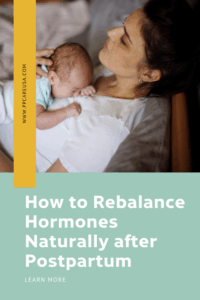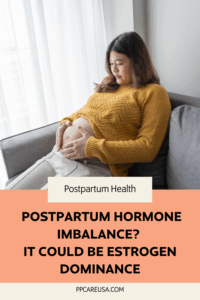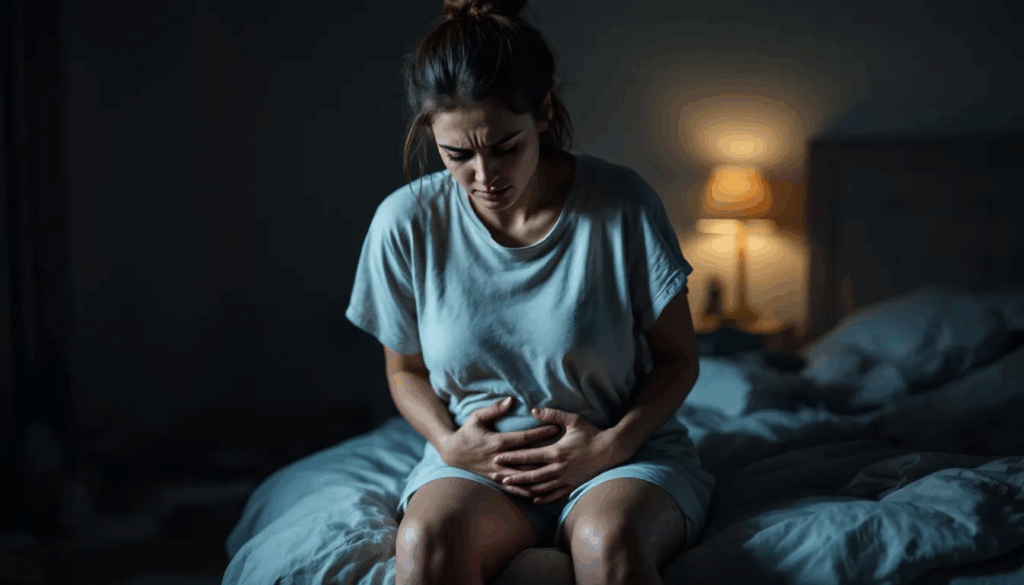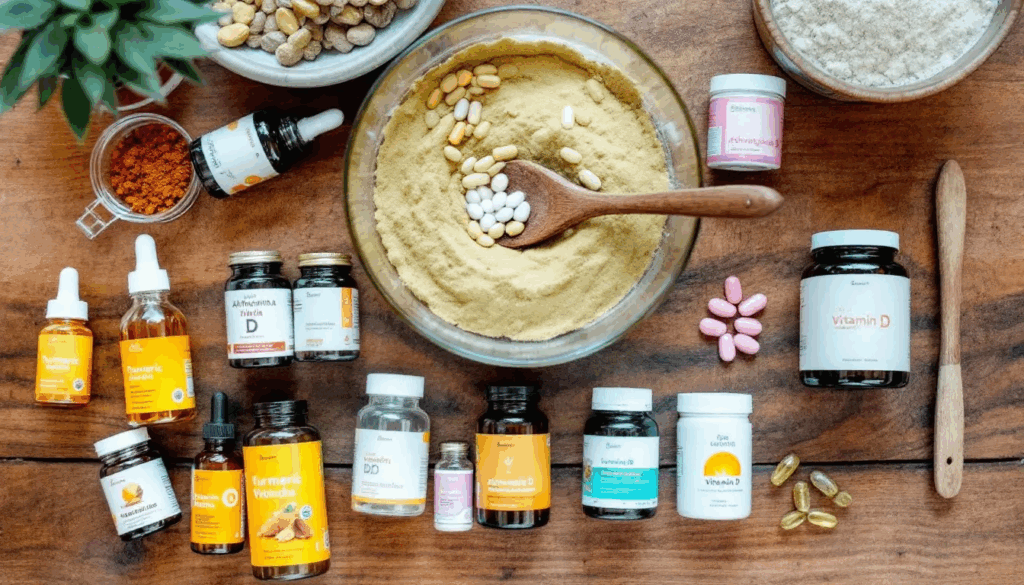If you’re dealing with unexplained weight gain, mood swings, irregular periods, and chronic fatigue, you’re not alone. These seemingly unrelated symptoms could point to a common hormonal imbalance called estrogen dominance, affecting up to 50% of women in their 30s and 40s (
Source). Despite its prevalence, this condition often goes undiagnosed in conventional medicine, leaving millions of women struggling with symptoms that significantly impact their quality of life.
Understanding estrogen dominance is crucial for women seeking to reclaim their hormonal health. This comprehensive guide will walk you through everything you need to know about this condition, from recognizing the symptoms to implementing natural solutions that address the root causes. You’ll discover how hormonal imbalances develop, why they persist, and most importantly, how you can restore balance naturally.
What Is Estrogen Dominance in Women?
Estrogen dominance occurs when estrogen levels are elevated in relation to progesterone levels in a woman’s body. This hormonal imbalance doesn’t necessarily mean you have too much estrogen in absolute terms – it means you have too much estrogen relative to your progesterone levels.
To understand this condition, it’s essential to know how estrogen and progesterone should work together during your menstrual cycle. Estrogen plays a vital role in sexual development and is the strongest estrogen your body produces. During the first half of your woman’s cycle (follicular phase), estrogen levels rise to prepare the uterine lining for potential pregnancy. After ovulation, during the luteal phase, progesterone levels should increase significantly to balance estrogen’s effects.
There are two main types of estrogen dominance:
Frank estrogen dominance: Both hormone levels are elevated, but estrogen is disproportionately high compared to progesterone.
Relative estrogen dominance: Estrogen levels may be normal or even low, but progesterone levels are significantly reduced, creating an imbalance where estrogen becomes dominant.
This hormonal imbalance is surprisingly common, with research suggesting that up to 50% of women in their 30s and 40s experience some degree of estrogen dominance. The condition is often overlooked in conventional medicine because symptoms can be attributed to stress, aging, or other factors. However, functional medicine practitioners recognize estrogen dominance as a significant contributor to many women’s health issues.
Estrogen Dominance Symptoms in Women
Women with estrogen dominance experience a wide range of symptoms that can affect multiple body systems. These symptoms often fluctuate throughout the menstrual cycle and may worsen during certain phases.
Physical Symptoms
The most common physical symptoms include:
- Breast tenderness and swelling, particularly before menstruation
- Weight gain, especially around the hips, thighs, and abdomen
- Persistent bloating and water retention
- Hair loss or thinning hair
- Headaches and migraines
- Cold hands and feet
- Increased body fat, particularly in the midsection
- Cellulite development
Menstrual Irregularities
Estrogen dominance significantly impacts menstrual health:
- Heavy periods with excessive bleeding
- Irregular periods or unpredictable cycles
- Severe PMS symptoms that interfere with daily life
- Premenstrual syndrome lasting longer than usual
- Shortened cycles or prolonged bleeding
- Increased menstrual cramping and pain
Emotional and Mental Symptoms
The nervous system is particularly sensitive to hormonal imbalances:
- Mood swings that seem unpredictable
- Increased anxiety and nervousness
- Depressed mood or feelings of hopelessness
- Irritability and anger outbursts
- Brain fog and difficulty concentrating
- Memory problems and forgetfulness
- Cognitive function decline
Sleep and Energy Issues
Many women with estrogen dominance struggle with:
- Insomnia or difficulty falling asleep
- Frequent night wakings
- Chronic fatigue despite adequate rest
- Low energy levels throughout the day
- Feeling tired but wired, especially at night
Sexual Health Impacts
Estrogen dominance affects sexual function:
- Decreased sex drive or low libido
- Vaginal dryness or changes in lubrication
- Reduced sexual satisfaction
- Changes in sexual development or function
These symptoms often vary depending on where you are in your menstrual cycle, with many women reporting that symptoms worsen during the luteal phase when progesterone should be highest.
What Causes Estrogen Dominance in Women?
Understanding the underlying causes of estrogen dominance is crucial for effective treatment. Multiple factors can contribute to this hormonal imbalance, often working together to create and maintain the condition.
Age-Related Factors
As women age, particularly after 35, the ovaries produce less progesterone while estrogen levels may remain relatively stable or fluctuate dramatically. During perimenopause, this imbalance becomes more pronounced as ovulation becomes less frequent, reducing progesterone production. This natural decline in progesterone levels creates relative estrogen dominance even when estrogen levels aren’t necessarily high.
Environmental Toxins and Xenoestrogens
Modern life exposes us to numerous chemicals that mimic estrogen in the body:
- Plastics containing BPA and phthalates found in food containers, water bottles, and personal care products
- Pesticides and herbicides on conventionally grown produce
- Chemicals in cosmetics and skincare products including parabens and synthetic fragrances
- Household cleaners and air fresheners containing endocrine-disrupting compounds
These xenoestrogens accumulate in fat tissue and can disrupt normal hormone balance, contributing to excess estrogen in the body.
Poor Liver Detoxification
The liver is responsible for processing and eliminating excess estrogen from the body. When liver function is compromised, the body cannot process estrogen effectively, leading to accumulation. Factors that impair liver function include:
- Excessive alcohol intake
- Poor diet high in processed foods
- Exposure to environmental toxins
- Chronic stress
- Certain medications
Gut Health Issues
The gut plays a crucial role in estrogen metabolism through the enterohepatic circulation system. Gut dysbiosis (imbalanced gut bacteria) can interfere with proper estrogen detoxification. Additionally, constipation allows estrogen to be reabsorbed into the bloodstream rather than eliminated, contributing to elevated levels.
Chronic Stress and Cortisol Production
Chronic stress leads to elevated
cortisol, which competes with progesterone for the same hormone receptors. High stress also depletes the raw materials needed for progesterone production, as the body prioritizes making stress hormones over reproductive hormones. This stress-induced progesterone deficiency contributes to relative estrogen dominance.
Medical Conditions
Several health conditions increase the risk of estrogen dominance:
- Polycystic ovarian syndrome (PCOS) affects hormone production and ovulation
- Polycystic ovary syndrome creates insulin resistance, which increases estrogen production
- Thyroid disorders that slow metabolism and hormone processing
- Insulin resistance that promotes estrogen production in fat cells
- Adrenal gland dysfunction affecting overall hormone balance
Lifestyle Factors
Daily habits significantly impact hormone balance:
- Excess body fat: Fat cells produce estrogen through the aromatase enzyme, creating a cycle where more body fat leads to higher estrogen levels
- Birth control pills that contain synthetic estrogens
- Hormone replacement therapy that may not include adequate progesterone
- Sedentary lifestyle that slows circulation and detoxification
- Poor sleep quality affecting hormone regulation

How Long Does Estrogen Dominance Last?
The duration of estrogen dominance varies significantly among women, typically lasting anywhere from several months to several years. The timeline depends on multiple factors, including the underlying cause, the severity of the hormone imbalance, and the treatment approach taken.
Several factors affect recovery time:
Age and Life Stage: Younger women may recover more quickly as their bodies are generally more resilient and have better hormone production capacity. Women in perimenopause may experience longer recovery times due to natural hormonal fluctuations during this transition.
Severity of Imbalance: Women with mild estrogen dominance may see improvements within 3-6 months of implementing natural therapies, while those with severe imbalances may require 12-18 months or longer for full recovery.
Treatment Approach: Those who address root causes through comprehensive lifestyle changes, stress management, and targeted supplementation typically recover faster than those who only treat symptoms.
Underlying Health Conditions: Women with conditions like PCOS, thyroid disorders, or chronic stress may require longer treatment periods as these conditions contribute to ongoing hormone imbalance.
Environmental Exposure: Continued exposure to xenoestrogens and other endocrine disruptors can prolong recovery time, making environmental toxin reduction crucial for healing.
Without proper intervention, estrogen dominance often worsens over time. The condition can create a self-perpetuating cycle where symptoms lead to increased stress, poor sleep, and unhealthy coping mechanisms, further disrupting hormone balance.
The connection between perimenopause and estrogen dominance is particularly important to understand. During this transition, which can last 10-15 years, hormone levels fluctuate dramatically. While estrogen levels may actually decline during perimenopause, progesterone levels typically fall much more rapidly, creating relative estrogen dominance that can persist until several years after menopause.
This is why addressing root causes rather than just managing symptoms is essential for long-term recovery. Women who focus on supporting their body’s natural detoxification processes, optimizing gut health, managing stress, and reducing environmental toxin exposure typically experience more complete and lasting recovery.
Estrogen Dominance Treatment for Women
Treating estrogen dominance requires a comprehensive approach that addresses the underlying causes rather than simply masking symptoms. The most effective treatment strategies focus on supporting the body’s natural ability to metabolize and eliminate excess estrogen while promoting healthy progesterone production.
The key to successful treatment lies in understanding that estrogen dominance is rarely caused by a single factor. Instead, it typically results from multiple interconnected issues including poor detoxification, gut health problems, chronic stress, and environmental toxin exposure. A holistic approach that addresses these root causes simultaneously provides the best outcomes for women seeking to restore hormonal balance.
1. Support Liver Detoxification
The liver is your body’s primary detoxification organ and plays a crucial role in estrogen metabolism. Supporting liver function is essential for helping your body process estrogen effectively and prevent its accumulation.
Phase 1 and Phase 2 Detoxification
Estrogen detoxification occurs in two phases. Phase 1 enzymes break down estrogen into metabolites, while Phase 2 enzymes prepare these metabolites for elimination. Both phases require specific nutrients to function optimally.
Foods that Support Liver Function:
- Cruciferous vegetables like broccoli, cauliflower, Brussels sprouts, and kale contain compounds that support estrogen metabolism
- Garlic and onions provide sulfur compounds essential for Phase 2 detoxification
- Turmeric contains curcumin, which supports liver enzyme function
- Green tea provides antioxidants that protect liver cells
- Beets support liver detoxification and bile production
Hydration and Alcohol Reduction
Adequate hydration is essential for liver function and toxin elimination. Aim for at least 8-10 glasses of filtered water daily. Reducing alcohol intake is equally important, as alcohol competes with estrogen for the same detoxification pathways and can overwhelm liver capacity.
Key Nutrients for Liver Support:
- B vitamins, particularly B6, B12, and folate, support methylation pathways crucial for estrogen metabolism
- Methylated folate is especially important for women with MTHFR gene variations
- Sulfur compounds from cruciferous vegetables and garlic support Phase 2 detoxification
- Magnesium acts as a cofactor in numerous detoxification reactions
2. Optimize Gut Health
The gut microbiome plays a critical role in estrogen metabolism through the production of an enzyme called beta-glucuronidase. Healthy gut bacteria help metabolize estrogen properly, while imbalanced gut flora can lead to estrogen reabsorption and elevated levels.
The Role of Gut Bacteria
Beneficial bacteria in the gut help break down estrogen metabolites and prepare them for elimination. When the gut microbiome is imbalanced (gut dysbiosis), harmful bacteria can produce excess beta-glucuronidase, which allows estrogen to be reabsorbed into the bloodstream rather than eliminated.
Dietary Fiber Recommendations
Fiber binds to estrogen in the digestive tract and helps escort it out of the body. Women should aim for a minimum of 35 grams of dietary fiber daily from a variety of sources:
- Vegetables (especially non-starchy varieties)
- Fruits (particularly berries and apples)
- Legumes and beans
- Nuts and seeds
- Whole grains in moderation
Probiotic Support
Incorporating probiotic-rich foods and supplements helps restore healthy gut flora:
- Fermented vegetables like sauerkraut and kimchi
- Kefir and yogurt with live cultures
- Kombucha and other fermented beverages
- High-quality probiotic supplements containing multiple strains
Addressing Constipation
Regular bowel movements are essential for estrogen elimination. Constipation allows estrogen to be reabsorbed, contributing to elevated levels. Strategies to promote regular elimination include:
- Adequate fiber intake
- Sufficient water consumption
- Regular physical activity
- Magnesium supplementation if needed
- Addressing underlying digestive issues
3. Manage Stress and Support Adrenals
Chronic stress is a major contributor to estrogen dominance because it depletes progesterone and disrupts overall hormone balance. The adrenal glands produce cortisol in response to stress, and this process competes with progesterone production.
The Stress-Hormone Connection
When the body is under chronic stress, it prioritizes cortisol production over other hormones, including progesterone. This “pregnenolone steal” depletes the raw materials needed for progesterone synthesis, contributing to relative estrogen dominance.
Stress Reduction Techniques:
- Meditation and mindfulness practices help regulate the nervous system and reduce cortisol levels
- Deep breathing exercises activate the parasympathetic nervous system
- Yoga and gentle movement combine physical activity with stress reduction
- Regular massage or acupuncture can help reset the nervous system
Sleep Optimization
Quality sleep is essential for hormone regulation and stress management. Women should aim for 7-9 hours of sleep nightly and focus on improving sleep quality:
- Maintain consistent sleep and wake times
- Create a dark, cool sleeping environment
- Avoid screens for at least one hour before bed
- Consider magnesium supplementation to promote relaxation
Adaptogenic Support
Adaptogenic herbs help the body respond more effectively to stress and support adrenal function:
- Ashwagandha helps regulate cortisol levels
- Rhodiola supports energy and stress resilience
- Holy basil promotes calm energy and hormone balance
- B vitamins support adrenal function and energy production
4. Balance Blood Sugar and Reduce Inflammation
Insulin resistance and chronic inflammation are closely linked to estrogen dominance. High insulin levels promote estrogen production in fat tissue and can worsen hormonal imbalances.
The Insulin-Estrogen Connection
Insulin resistance leads to elevated insulin levels, which stimulate the aromatase enzyme in fat cells. This enzyme converts androgens to estrogen, creating a cycle where insulin resistance leads to increased estrogen production, which can further promote weight gain and insulin resistance.
Anti-inflammatory Diet Principles:
- Emphasize omega-3 fatty acids from fatty fish, walnuts, and flax seeds
- Include antioxidant-rich foods like berries, leafy greens, and colorful vegetables
- Choose high-quality proteins at each meal
- Limit processed foods, refined sugars, and trans fats
Meal Timing and Macronutrient Balance
Stable blood sugar supports healthy hormone levels:
- Eat balanced meals containing protein, healthy fats, and complex carbohydrates
- Avoid skipping meals or extreme calorie restriction
- Consider intermittent fasting under professional guidance
- Time carbohydrate intake around physical activity when possible
Foods to Avoid:
- Processed and packaged foods high in additives
- Excess sugar and refined carbohydrates
- Trans fats and hydrogenated oils
- Excessive caffeine and alcohol
- Foods high in omega-6 fatty acids without balancing omega-3s
Supplements for Women with Estrogen Dominance
While diet and lifestyle form the foundation of treatment, targeted supplementation can provide additional support for women with estrogen dominance. The right supplements can help optimize estrogen metabolism, support progesterone production, and address underlying imbalances that contribute to the condition.
Key Nutrients for Hormone Balance:
DIM (Diindolylmethane) is a compound derived from cruciferous vegetables that supports healthy estrogen metabolism. It helps the body process estrogen into beneficial metabolites rather than harmful ones. Typical dosing ranges from 100-300mg daily.
Calcium D-Glucarate supports the liver’s ability to eliminate estrogen by inhibiting the beta-glucuronidase enzyme that can cause estrogen reabsorption. This supplement is particularly helpful for women with gut health issues.
Magnesium is involved in over 300 enzymatic reactions and is crucial for hormone production and stress management. Many women are deficient in magnesium, which can worsen estrogen dominance symptoms.
Vitamin B6 supports progesterone production and helps the liver metabolize estrogen. It’s particularly beneficial for women experiencing PMS symptoms and mood-related issues.
Progesterone Support:
Chaste Tree Berry (Vitex) is an herb that supports the pituitary gland’s production of luteinizing hormone, which stimulates progesterone production. It’s especially helpful for women with luteal phase defects or irregular periods.
Progesterone cream may be beneficial for some women, but it should only be used under the guidance of a knowledgeable healthcare provider who can monitor hormone levels and adjust dosing appropriately.
Liver Support Supplements:
Milk thistle contains silymarin, which protects liver cells and supports detoxification processes. It’s particularly beneficial for women with compromised liver function.
N-Acetyl Cysteine (NAC) supports glutathione production, the body’s master antioxidant, and helps protect the liver during detoxification.
Methylated B vitamins are essential for women with MTHFR gene variations who may have difficulty processing standard forms of these vitamins.
Gut Health Supplements:
High-quality probiotics containing multiple strains help restore healthy gut bacteria essential for proper estrogen metabolism.
Digestive enzymes can improve nutrient absorption and support overall digestive health.
Fiber supplements like psyllium husk or ground flax seeds can help increase dietary fiber intake for women who struggle to get enough from food sources.
Important Considerations:
Working with a healthcare provider experienced in hormone health is crucial when implementing a supplement protocol. Individual needs vary significantly, and what works for one woman may not be appropriate for another. Professional guidance ensures supplements are chosen based on specific symptoms, lab results, and individual health history.
Quality considerations are equally important. Look for supplements that are third-party tested for purity and potency, free from common allergens, and manufactured by reputable companies with good manufacturing practices.
Will You Feel Normal Again with Estrogen Dominance?
The encouraging answer is yes – hormone balance can be restored with a consistent, targeted approach to addressing the root causes of estrogen dominance. Many women successfully overcome this condition and return to feeling energetic, emotionally balanced, and physically comfortable.
Realistic Timeline Expectations:
Recovery from estrogen dominance is a gradual process that requires patience and consistency. Most women begin to notice initial improvements within 3-6 months of implementing comprehensive treatment strategies. These early improvements often include better sleep, more stable moods, and increased energy levels.
Significant changes in symptoms like weight management, menstrual regularity, and overall hormone balance typically occur within 6-12 months of consistent treatment. However, some women may require 12-18 months or longer for complete recovery, especially if they have underlying conditions like PCOS or significant environmental toxin exposure.
Success Stories and Recovery Patterns:
Many women who have successfully reversed estrogen dominance report similar patterns in their recovery:
- Months 1-3: Improved sleep quality, better stress management, initial mood stabilization
- Months 3-6: More regular menstrual cycles, reduced PMS symptoms, gradual weight management
- Months 6-12: Significant improvement in energy levels, clearer thinking, stable mood, healthy weight maintenance
- Beyond 12 months: Sustained hormone balance, minimal symptoms, improved quality of life
Tracking Progress:
Monitoring your progress helps maintain motivation and allows for treatment adjustments:
- Symptom journaling to track changes in energy, mood, sleep, and menstrual patterns
- Regular hormone testing to monitor estradiol levels, progesterone levels, and other hormone levels
- Energy level assessments throughout the day and week
- Sleep quality tracking using apps or simple daily notes
- Mood and cognitive function observations
The key to successful recovery lies in addressing multiple factors simultaneously rather than focusing on just one aspect of treatment. Women who combine dietary changes, stress management, environmental toxin reduction, targeted supplementation, and professional support typically achieve the best outcomes.
When to Seek Professional Help:
While many aspects of estrogen dominance can be addressed through lifestyle changes, working with knowledgeable healthcare providers significantly improves outcomes. Consider seeking help from functional medicine practitioners, naturopathic doctors, or integrative physicians who understand hormone balance and can provide:
- Comprehensive hormone testing
- Personalized treatment plans
- Monitoring of progress and treatment adjustments
- Integration with any necessary conventional treatments
- Support for underlying conditions that contribute to hormone imbalance
Remember that recovering from estrogen dominance is not just about eliminating symptoms – it’s about creating a foundation for long-term health and vitality. The lifestyle changes and health practices that restore hormone balance also support bone health, cardiovascular health, cognitive function, and overall well-being.
Conclusion
Estrogen dominance is a common but treatable condition affecting millions of women worldwide. While the symptoms can be challenging and significantly impact quality of life, understanding this hormonal imbalance empowers women to take control of their health and implement effective solutions.
The path to recovery lies in addressing root causes through a comprehensive approach that includes supporting liver detoxification, optimizing gut health, managing stress, balancing blood sugar, and implementing targeted supplementation. This holistic strategy not only helps restore hormone balance but also creates a foundation for long-term health and vitality.
Remember that hormone balance is achievable with proper support, guidance, and consistency. The journey may take time, but the investment in your hormonal health pays dividends in improved energy, mood stability, better sleep, and overall well-being. Every woman deserves to feel vibrant and healthy, and with the right approach, estrogen dominance can become a thing of the past.
If you’re struggling with symptoms of estrogen dominance, consider working with a knowledgeable healthcare provider who can help create a personalized treatment plan. Your hormone health is an investment in your overall quality of life – and taking that first step toward balance is one of the most important decisions you can make for your long-term wellness.
Pin This for Later:










Get in touch